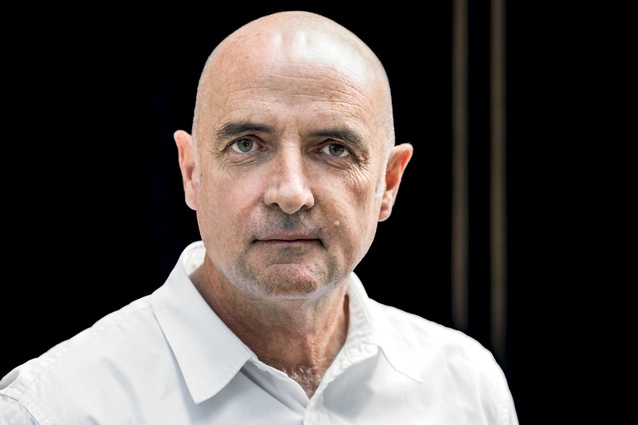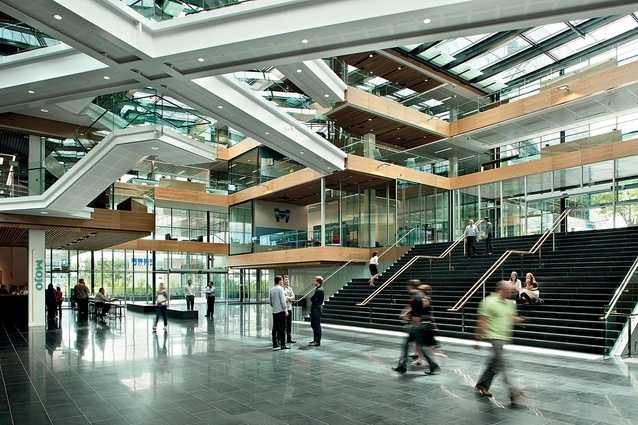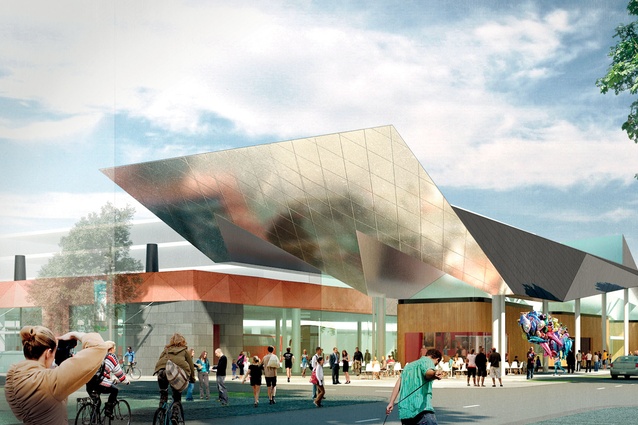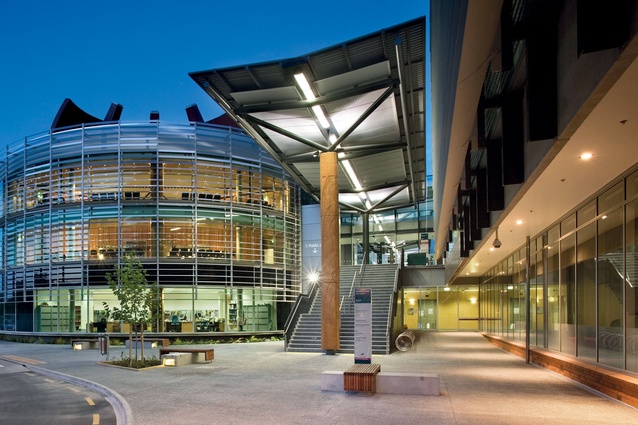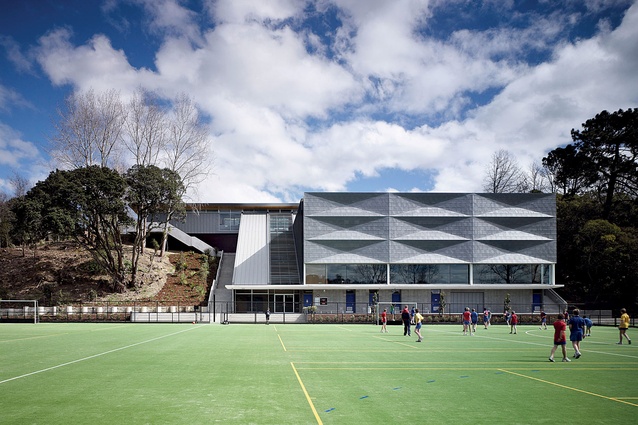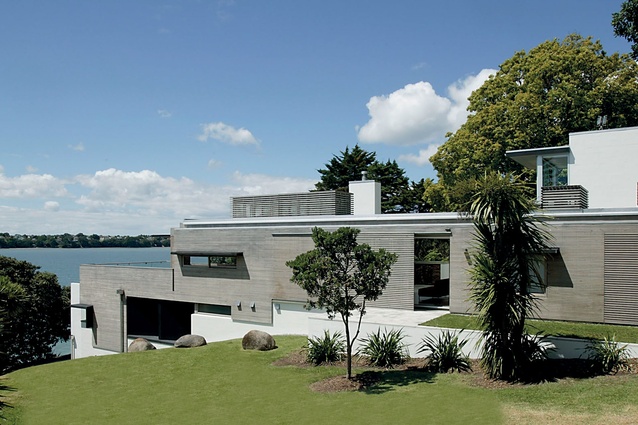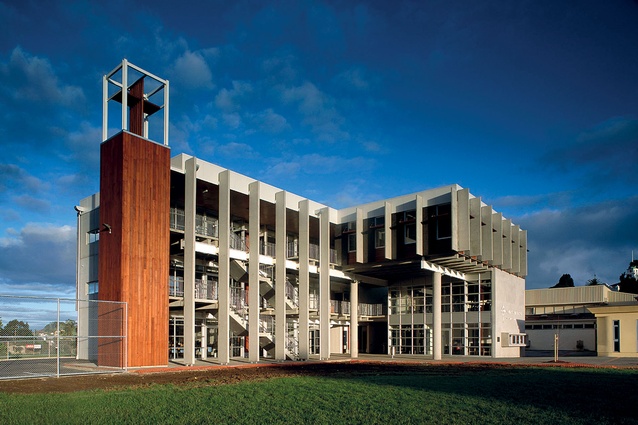With Patrick Clifford
The 2014 NZIA Gold Medal winner Patrick Clifford talks about his career with Justine Harvey at his Shortland Street studio in Auckland.
Architecture New Zealand: Let’s start at the beginning; where did you grow up?
Patrick Clifford: I grew up in Khandallah in the misty hills of Wellington. We lived in a Californian bungalow like almost everyone else around us. It was during the ’70s when my engagement with the architectural world began. Khandallah is one of those hilly suburbs in Wellington where you can see most of what is being constructed. Roger Walker and Ian Athfield built quite a lot of houses on the hills and Ath, of course, built his own house.
ANZ: It’s an incredible view from up there.
PC: Yes, everything is very prominent. But my family didn’t have any particular connection with architecture.
ANZ: What did your parents do?
PC: My father was an accountant by profession but a civil servant by occupation. My mother worked raising five children. Having spent four years away in the eighth army during World War Two, my father’s view regarding employment was that you did what was possible, so whether he ultimately thought it was great to be a civil servant is probably a moot point. Anyway, we certainly grew up in an environment that encouraged debate and dialogue and encouraged us to do whatever we wanted to do; my parents certainly supported that at every level.
ANZ: And did you think you wanted to do architecture?
PC: I’ve never quite figured that out. I certainly enjoyed making things. In the neighbourhood there were one or two people who were architects. To make the trip from Khandallah to Wellington, past Ath’s house, during that period was to experience architecture, and I certainly had a feeling of Wellington as a constructed city. I had an idea that it would be good to do something that was not just being in an office. So, at the end of secondary school, I and a couple of people in the same year group enrolled in architecture. I had a slight diversion into thinking I might study law, so I did a term of that but then reverted back to architecture intermediate [at Victoria University of Wellington]. That wasn’t all plain sailing because I wasn’t a particularly dedicated student but, sufficient to say, on my third application to the School of Architecture [The University of Auckland], I gained admission and duly headed off to Auckland from the Government Architect’s Office in the Ministry of Works, where my father had organised some part-time work for me. Lots of people went through there and, of course, the architectural scene in New Zealand at that time was different in that there were a lot more architects employed by government agencies or local body agencies.
ANZ: What was Architecture School like for you at that time?
PC: It was different than going to university or, at least, what I’d experienced, which was enrolling in courses, attending lectures and tutorials and so on. You’re now in a year group, which was divided, at that time, into studio groups of which there were three, each offering a different philosophical view and teaching style, and you had to pick where you wanted to go.
ANZ: And what about the ideas around at the time and which teachers influenced your own thinking?
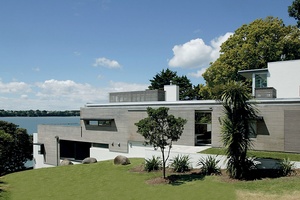
PC: There are particular memories that I certainly have of people from that time. We learnt drawing from Pat Hanley, who was a very helpful and incredibly encouraging teacher, and people like Fred Beckett, Dave Mitchell and Mike Austin, who were practising and working in a completely different way, and Claude Megson, who I did quite a lot of studio work with. There were visiting architects, like Marshall Cook, coming into the School and offering studio programmes.
ANZ: Are there any entertaining moments that stick in your mind?
PC: I can still vividly remember Claude Megson in the studio one day yelling out at Peter Bartlett, “I’m twice the architect you are!” Peter Bartlett was the distinguished teacher, academic and practitioner who designed the performing arts building at Auckland Grammar, amongst other things.
ANZ: Claude sounds like quite a character. Were you also protesting at the time?
PC: We boycotted a couple of construction exams. I think every cohort of architecture students protests about the way something is taught and we didn’t think we were learning anything so we didn’t sit the exam.
ANZ: I wonder if, at the beginning the year, the School thinks ‘so what are they going to protest about this time?’
PC: It was pretty healthy. Alan Wild [dean of the School of Architecture] was quite happy to engage with that.
ANZ: Peter Wood made an interesting comment in his review [Architecture NZ 01.2014] of the Hub (Victoria University of Wellington) about students protesting and how important it is to have a quad.
PC: It’s absolutely important to have places for students to gather, to encourage that involvement. The School of Architecture was an environment that had a lot more complexity than ‘you’re coming here to just be taught something about architecture’. There were complex personal relationships and views about what architecture should be and how it should be taught and so on. As a student, you have to navigate your way through that and, at some point, hopefully form a view yourself about what you think is important. My recollection of that time is that a lot of the teaching was fairly laissez faire; it didn’t offer a strong view. The strong view was that students should figure out, based on their own experience and understanding, how to make architecture. There were exceptions to that: people like Claude Megson, who said, “This is how I do it and, if you’re going to be in my studio, you need to do it this way”. I think there are advantages and disadvantages.
ANZ: You probably want a balance of both, I guess. You need to find your own way but, if you’re working for an architecture firm, you have to do it that firm’s way too.
PC: Well, there’s that. I don’t know that you need to teach people to toe the line; I’m not a fan of that at all but that doesn’t mean to say I don’t have a clear view about what we’re trying to do here in learning about architecture. Yes, life experience and opinion is important but, like most disciplines, architecture draws a lot on itself and, therefore, to know something about it, i.e. precedents and buildings, and to know them, not just at the level of looking at the pictures, but the coding of them, like plans and sections, in my view is really helpful. So, to some extent, the education lacked some of that discipline.
ANZ: Do you think that the laissez-faire attitude was possibly a good thing for your generation, in the sense that New Zealand had traditionally followed overseas styles, so perhaps a laissez-faire attitude was a way for new generations of architects to evolve with some different ideas based more in the New Zealand context?
PC: Maybe, but in the ’50s and ’60s some New Zealand architects had formed a view that modern architecture in New Zealand should be its own version: people like the [Architectural] Group and so on, who we tend to celebrate now but it wasn’t being taught about at Architecture School back then. It wasn’t like we were being educated in an environment that said, “Look, here’s what’s happened before”. It was rather more “you figure out your own path”.
ANZ: A little bit directionless, you mean?
PC: Well, it was a challenge for students to figure out how to approach this. But there was a balance with the Claude Megson approach of “do it this way”. So, as a student, there’s quite a lot of decisions to be made in terms of the ‘how’ – some of which, you probably don’t figure out what effect it had until a few years later.
ANZ: So when you left university, did you travel straight away?
PC: No, I’d had a scholarship from the government so I went back and worked part time at the Ministry of Works in Wellington for a couple of years. Then I travelled.
ANZ: The big OE? Did you go straight to London?
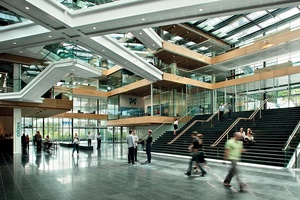
PC: No, I spent a bit of time in Tokyo, Japan, on a student exchange programme. I visited some of the metabolist work, contemporary work and the Olympic Games complex. The experience of Japanese urbanism was so different from my own experience.
ANZ: The scale?
PC: The scale, the density, as in ‘lots of it’, but the scale of it being quite small but highly aggregated and, obviously, the density of people and so on. Then, there’s the historical context, in terms of tradition and making and craft, remaking and maintenance – a commitment to all of that. I enjoyed that thoroughly. I also spent time in India on that trip and up in the Himalayas, then other countries until I arrived in London.
ANZ: Who did you work for?
PC: Small practices and bigger firms like Sheppard Robson – that was an interesting big office – and then I worked for a Turkish architect, Ilhan Zeybekoglu, who was a teacher at Harvard. One of his students established a firm and invited Ilhan to contribute so I went and worked for him. I don’t think anything particularly distinguished was built. We did lots of submissions and, in between times, I did other things like travelling and sailing – I sailed across the Atlantic. The experience with Ilhan was formative. I liked him. He was very direct about whether he thought something was appropriately done or not and, if he didn’t think it was, he said, “You just need to do that again” but also about what he’d done: “This doesn’t work, so we’re going to work this plan out a hundred times until it all seems to fit together.” So I was working directly with someone who had a good pedigree or background: he was teaching at a good place with very good students. He’d taught with Louis Kahn, who was the big influence in his professional life, and he’d gone to Harvard to study in that environment. He had the view that this is incredibly important and we’re going to do this properly. Although I’m not saying he was necessarily right about all of that.
ANZ: But he had a view and he stuck with it.
PC: He stuck with it and he had an incredibly committed approach. That’s not to say that there weren’t people in other places I’d worked who were like that but I just hadn’t had the opportunity to work closely with them. He really influenced me into grasping that, firstly, it is really enjoyable to work through things at this level, I enjoyed the intellectual and the physical discipline and challenge of all of that, and, secondly, I realised it is important.
So, in the end, Malcolm [Bowes, co-founder of Architectus] came and worked there as well. Mike [Michael Thomson, the other co-founder of Architectus] was working at [Terry] Farrell’s for a long time and that time was coming to an end, so we discussed the idea of coming back [to New Zealand] and setting up an office and, at the end of ’86, that’s what we did.
ANZ: Who were you influenced by? Who was in the architecture scene in London at that time?
PC: Well, the figures around were Stirling, Wilford, Foster, Rogers and Grimshaw – the so-called high-tech group but the postmodern period was strong: Michael Graves in America, for example. The post-modern influence translated frighteningly into the architecture of the day-to-day, which is what most people were involved in. So, when we came to set up a practice, we’d inherited this influence around the American Louis Kahn; we loved the buildings of Richard Meier – the early houses, the white Douglas house – and we quite liked the Italian rationalists – Giorgio Grassi – this very clear geometry and an organisational point of view. So, we came back to New Zealand and, certainly within residential architecture at that time, you can over-generalise but the postmodern influence preferred something a little Italian, rather than something like a Richard Meier. So it was quite difficult to figure out where to fit.
ANZ: Weirdly, that’s more fashionable now.
PC: It’s a totally weird thing that the modern is now, though I suspect that period may have passed.
ANZ: Did you come back with Malcolm?
PC: I came back first but Malcolm arrived a couple of months later and, by that point, I’d rented a little office in Newmarket, near the Hitchcock and Sargisson office, as it was called. Malcolm and Mike had both worked for Cook Hitchcock & Sargisson, so I called in there and they gave us some work – they were very generous in helping us. And New Zealand, at that time, was rather buoyant.
ANZ: So you set your office up; when did the breaks come and were there just the two of you?
PC: There was Michael Thomson as well – he came a few months later and off we went. The first nine months in Auckland were busy and then, in September 1987, the crash was very dramatic here. We had a fledgling architectural practice and none of us was born in Auckland, so we didn’t have any particular relationships; we were just itinerant so we struggled. There was the odd house project and we might win work through some social interaction or because someone said, “Oh, look, there’s a firm of architects down there”, but our leverage was reasonably modest in terms of saying “you should do it this way” and people have strong views about houses; that was challenging. And we wanted to do larger-scale work.
Then, in 1989, the Museum of New Zealand Te Papa Tongarewa competition came along; it was an open international competition and there was this whole idea that a building should be able to embody the idea of biculturalism. The aspirations were incredibly exciting and challenging. We were short-listed which was just great. But Gehry wasn’t short-listed and there was this never-ending discussion about, “Well, we could have had Gehry” but we would say, “Hey, you could have had ours”. If you’re going to have that discussion, at least have it on the basis that, “Did he do a good scheme or not?” I’m not saying whether he did or didn’t, but that’s what history remembers about that competition.
ANZ: You’d joined forces with Cook Hitchcock & Sargisson and John Scott, hadn’t you?
PC: Yes. We did the first stage and we must have received some money to do the second stage. There were five firms and it was a big deal: going to Wellington to the Fletcher Challenge headquarters and presenting the project. We were halfway through the presentation when a person came in with a little pink Post-it note saying, “Just leaving Te Horo” because John Scott was supposed to be at the presentation but had stopped for a rest in his car, fallen asleep and never got to the interview. So it was Marshall [Cook] and I doing it but it was great.
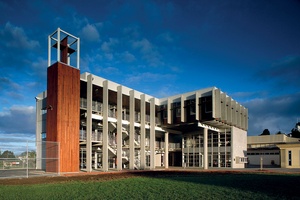
Part of the challenge of these things is that the selection panel has to think that they’d quite like to work with you. There’s more to it than just the quality of the work but, needless to say, that’s an influence. We thought we produced a really powerful project, that we were pretty close, although we didn’t get the job. Of course, life would have been different if we had. But it was a great experience for Architectus; it gave us some exposure or whatever you want to call it. The work was published and it was well regarded. It was an intelligent project with a strong idea and I think it gave us the opportunity to enter the competition for the buildings at the University of Canterbury – the Sciences West Precinct, which came along in 1994. But there was quite a long time between those things happening.
In between, we did a lot of work, Malcolm in particular, in Thailand with Marshall Cook, so the relationship with Cook Hitchcock & Sargisson was still very strong. That kept us going but it was pretty hard to make a living and I don’t think we ever gave up, in the sense that we needed to abandon what we thought was important. We built things and we learnt a lot.
In 1991, my wife Leslie and I bought a site in Kelvin Road and over quite a long period of time I designed the house and it started to be built in 1993. It was partly built when Leslie received an important job offer in New York so we went there around 1993/94. I came back quite a few times while that was being built. We returned in 1994, completed the kitchens and bathrooms and moved into it. At that time, we also entered the Sciences West Precinct competition, which we won. It was to design a library and also the Mathematics, Statistics & Computer Science Building, now known as the Erskine Building. It was assumed that two architects would be chosen: one to do each building and there were about 14 firms competing. We won both of them, the library first and, then, we had a run-off with Jasmax for the Erskine Building. We had to do another stage so the pressure was on. We won. Of course, history says the library has never been built, so life could have been different if we had only won the library and the Erskine Building had never happened.
ANZ: So that was your big break.
PC: Yes, that made all the difference. We went from having a few house alterations and institutional projects to a big project and a client who was fully engaged. Socially, environmentally and constructionally, the building is really interesting; it had all of the things that we were interested in. We built it and, in the intervening period, we entered other competitions and won other jobs.
ANZ: Working on those early projects, you must have formed a way of working together.
PC: Yes, we had generally figured out where our interest lay in terms of the language of architecture. We’re very interested in the way of building things: the tectonics, for want of a better term. The relationship between structure and services, the role of ordering devices, organisational devices and, particularly, as we got into these university projects, the way in which social organisations would inform what we’re doing, as well as the appropriate imagery and the relationship to context.
The projects in Christchurch have obviously created an opportunity to build into a context that has a very strong architectural character and history and culture. At the campus, as well as in Christchurch generally, there are a lot of cast-in-situ and pre-cast concrete buildings with the materials of the Canterbury Plains – that was the language that existed so our buildings in Canterbury draw strongly on that, as does the library that wasn’t built. There are some references to the agricultural context; the roof is made up of an exposed steel structure, which was related to the boom sprayers that we saw on the Canterbury Plains.
We’ve just always had a real interest and commitment to making things work as well as they can and that seems to us to be just what one should do. A project like St Peter’s College on the motorway has a strong and clear identity; it comments about the place it is but it also sets up a very heavy concrete shell that protects that building from the noise and grime and grit of the motorway, so it has an environmental response as well.
ANZ: Utilising a variety of materials and being very careful and considered in their application seems to be important in the way you work.
PC: Well, sometimes the buildings we’ve made are formally quite simple but, therefore, it’s very important that the materials tell something about the form and the language. We recognise that simple materials can be made a whole lot more elegant if they’re brought together with another, so the juxtaposition of materials benefits the whole. Concrete blocks with timber are quite different than concrete blocks with other concrete blocks and there’re some very simple relationships that you can make. We tended to use materials to code and describe buildings, so heavy walls enclosing certain parts contrast with other materials or glazing describes lighter areas. The Trinity Apartments building [in Parnell], for example, has heavy panels on each end and the apartments are open across the plan. We’ve been quite clear about bracketing things, anchoring projects.
So we’ve formed some approaches for how we go about doing things and we continue to evolve those in a way we understand. We still make physical models to explore things, look at options and refine what we do. We’re trying to make the architecture dense. It might need only a few moves to create the ability to work on lots of different levels: formally, structurally, environmentally and socially. We like the idea of making buildings that are deep and thought-through in a way that gives them power with lots of layers to them. We want them to be enduring. I enjoy lots of other architecture but, when it comes to our own work, that’s how we like to do it. It’s intellectually satisfying and I like to think it makes good buildings in the long term.
ANZ: You’ve certainly produced a variety of work, including a lot of projects in West Auckland.
PC: Yes, the civic centre, the train station in Henderson and the New Lynn station – and we subsequently added masterplanning work to that – the New Lynn Community Centre near the train station. Two of these projects were collaborations with Athfield Architects, who we’d became involved with through Jade Stadium, the old redevelopment of Lancaster Park, which was an important project for us.
More recently, we designed the Telecom building, which is substantial; we continue to really enjoy designing apartments and we have been very involved also in the urban realm, such as the initial work in the viaduct, then the Queen Street project and 10 years of work in the Wynyard project.
ANZ: The Wynyard Quarter has been really successful. So, what are you working on now?
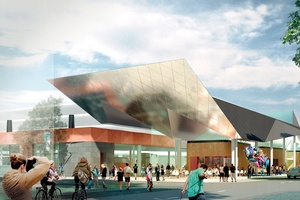
PC: We continue to be involved with education; we have our fourth building at St Peter’s College and probably the fourth or fifth at Auckland Grammar. These are long relationships over decades and that’s very satisfying. A new swimming pool and sports centre at St Cuthbert’s College will finish this year. The extension to the Manukau Courts is under construction and we have projects in Christchurch: a new chapel at St Andrew’s College, the bus interchange, and the central library with Schmidt Hammer Lassen from Denmark. We’ve also just finished a small historical archive in Thames and a little house on Waiheke Island.
ANZ: You have really embraced the collaborative process, haven’t you?
PC: Yes, I greatly appreciate this medal but it’s not at the expense of acknowledging Mike and Malcolm and, more recently, Carsten. There are also Architectus people who have made a huge contribution over 10 or 15 years, as well as collaborations with, particularly, Athfield Architects and Cook Hitchcock & Sargisson, as it was originally known, and now Cook Sargisson & Pirie. And I’ve worked a lot with Lindsay and Kerry Clare in Australia and recently with John Hockings on the Queen Elizabeth II courts in Brisbane and on the the criminal courts competition in Holland. It’s also important to recognise Dave Fullbrook and other people we’ve worked with for years so that this is seen in the context of a collaborative environment.
ANZ: Were there many disappointments because, in architecture, you do become used to the lost opportunities? Do you learn to brush them off?
PC: There’s no brushing them off. It doesn’t get any better, I can assure you, but maybe that’s important. I don’t know what other people would say but I doubt they’d say any different and, of course, time makes you wiser about these things. In the early days, you can’t see past your own project but, as time goes on, you can look at it in a more objective way.
ANZ: It’s a very consuming profession – a lifestyle as opposed to a job.
PC: Yes and it’s important to say that it requires support outside one’s office life: my wife Lesley, of course, and our three children: Phoebe, Stella and Theo.
ANZ: How many people are working in the office?
PC: 45. These days, we have more projects with deadlines every week, so you can’t simply drop everything and fix it by everyone coming in on the weekend. The office and people can’t operate like that so we have to be organised. But that doesn’t make it any less frenetic – it’s just fun in a different way.
ANZ: And that’s why you do it.
PC: Yes, I think the creative process is about making connections and seeing relationships between one thing and another – abstract ideas – and the way in which you’re going to translate that into some sort of built form.
ANZ: Somehow you hope the magic will happen?
PC: And I think you generally rely on the magic happening, or something happening. Whether it’s magic or not remains to be seen.
ANZ: Everything in its place.
PC: Yes because often in circumstances where there’s a time pressure, you hope that you can do this thing; I think I really enjoy that. We see some correlation between what the project wants to be and the context or some idea. We want to be able to reduce the project to some simple diagrams, some coherent understanding that encapsulates the essence of what it is we’re doing.

